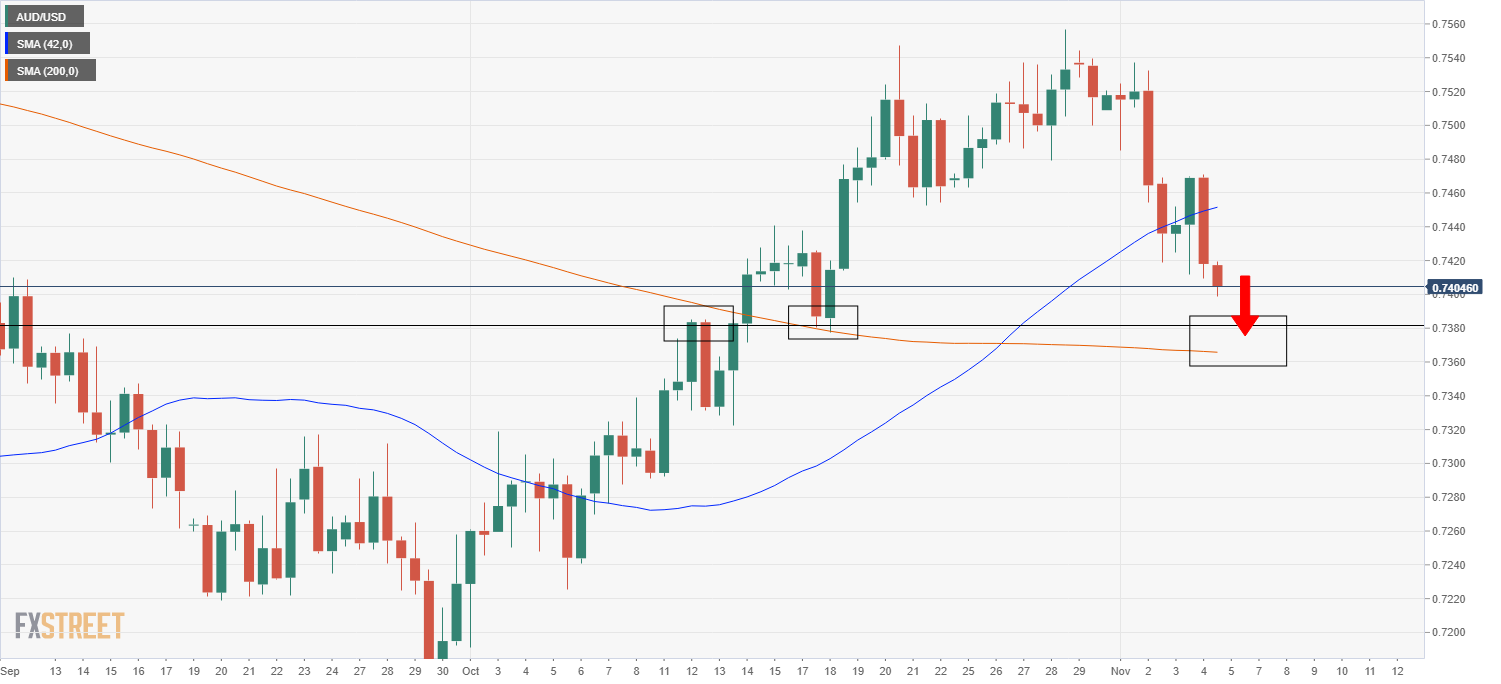- Analytics
- News and Tools
- Market News
- AUD/USD loses grip on 21DMA, now testing support at 0.7400 level
AUD/USD loses grip on 21DMA, now testing support at 0.7400 level
- AUD/USD is currently at multi-week lows testing the 0.7400 level to the downside.
- The pair has been losing ground amid a broad USD pick-up, perhaps driven by good US jobs data.
AUD/USD has been heading lower over the last few hours and is currently probing the 0.7400 level, meaning it is at its lowest level since 18 October and has now seemingly lost its grip on its 21-day moving average (DMA), which currently resides in the 0.7430s. If the 0.7400 level goes, that could open the door to some more selling pressure, with bears perhaps targetting the 50DMA at 0.7360 and support around the 0.7380 level just above it.

Aussie rollercoaster
The pair has been on a bit of a rollercoaster over the last 24 hours, initially dropping to fresh multi-week lows under 0.7420 at the start of Wednesday’s US session amid strong US ADP and Service PMI data (both for October), before reversing higher amid broad dollar weakness following a more dovish than expected Fed policy announcement, with the exchange rate peaking in the 0.7470s.
The reversal back lower again and to fresh lows for the week since the start of the Thursday Asia Pacific session is mostly down to a pick up in USD strength; analysts seem to have arrived at the conclusion that, net-net, Wednesday’s Fed policy announcement wasn’t as dovish as first thought, as, while the bank did maintain its label of high inflation as transitory and say it wants to be patient on rate hikes, it also appeared to open the door for earlier rate hikes and a potential acceleration of the pace of QE tapering in early 2022. Thus, money market pricing for Fed rate hikes beginning in mid-2022 has been left relatively unchanged. This money market reaction contrasts with the RBA’s successful attempt at their rate decision earlier in the week to dampen market expectations for a rate hike in 2022.
The US dollar is getting further tailwinds on Thursday amid sharp losses in GBP after the BoE failed to live up to market hype for a rate hike and following another strong US weekly jobless claims report. Initial Jobless Claims (IJC) fell to a fresh post-pandemic low of 269K (that’s four weeks on the bounce of IJC coming in under 300K), leaving it now not far above the 200-250K range historically associated with a healthy US labour market. Stronger than expected Australian Retail Sales data for Q3 (sales dropped 4.4% QoQ due to lockdowns, less than the 4.6% expected decline) and Trade Balance numbers (the Aussie trade surplus came in at A$ 12.243B in September, a smaller than expected decline from A$ 15B in August) have failed to support the Aussie, which the third-worst performing G10 currency on the day (only GBP and NZD are faring worse).
Looking ahead, the main event for FX markets now is Friday’s US labour market report. If strong, AUD is vulnerable to further selling pressure.
© 2000-2024. All rights reserved.
This site is managed by Teletrade D.J. LLC 2351 LLC 2022 (Euro House, Richmond Hill Road, Kingstown, VC0100, St. Vincent and the Grenadines).
The information on this website is for informational purposes only and does not constitute any investment advice.
The company does not serve or provide services to customers who are residents of the US, Canada, Iran, The Democratic People's Republic of Korea, Yemen and FATF blacklisted countries.
Making transactions on financial markets with marginal financial instruments opens up wide possibilities and allows investors who are willing to take risks to earn high profits, carrying a potentially high risk of losses at the same time. Therefore you should responsibly approach the issue of choosing the appropriate investment strategy, taking the available resources into account, before starting trading.
Use of the information: full or partial use of materials from this website must always be referenced to TeleTrade as the source of information. Use of the materials on the Internet must be accompanied by a hyperlink to teletrade.org. Automatic import of materials and information from this website is prohibited.
Please contact our PR department if you have any questions or need assistance at pr@teletrade.global.















